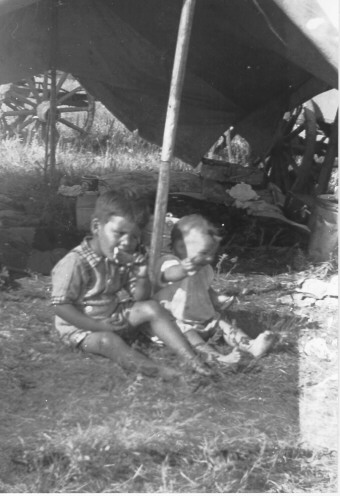This Website is owned and maintained by the Keeseekoowenin First Nation History Committee and published under the authority of the Chief and Council of Keeseekoowenin Ojibway First Nation.
The images and text contained in this website are the property of the Keeseekoowenin Ojibway First Nation
©Keeseekoowenin 1998

and the Indian Picnic/Sports Day
by Walter Archibald Scott
Chief Okanase had a favourite place. He seemed to like to camp in the Little Saskatchewan valley where the Riding Mountain House HBC Post was later established in 1868. This is where Chief Okanase spent his last days and is buried there. The place was called Sacketawaquan, meaning "Where Big Timber runs out onto the Prairies". The heavy timber runs out onto the prairie in a point ending near the Chief's old campground.
After a winter of trapping, hunting and the buffalo chase. It was hard work killing the Buffalo. Skinning the animal, butchering the meat and curing it, and tanning the hides. The cured meat was made into kaskeewuk and nokeewaquanuck, then into peemeekayegan or "pemmican". After all this was done and in early summer, the sons and families of Michel Cardinal would gather at Riding Mountain House for a get-together, to visit with friends and relatives. There were meetings and a lot of sports.
After Treaty #2 was signed in 1871, treaty was paid at this gathering at Riding Mountain House. The sports consisted mostly of Horse Racing, foot racing, high jump, long jump, football (soccer). The women played a kind of field hockey. The ball was made of pick-and-strip willow, and hockey sticks of bent willow.
After Chief Okanase died, the Riding Mountain House post was moved to where the village of Elphinstone now is, and the meeting grounds were moved to where the Keeseekoowenin Band Office is now. This was a grassy plain, ideal for a big camp. This camp ground was used as a meeting and sports ground up to the early 1940's. After World War II, the sports day was held in the village of Elphinstone - it seemed the end of the Big Camp on the reserve.
When Keeseekoowenin Indian Reserve #61 was formed, this was the time the country started to be settled. The new settlers, such as the Mortons, Geekies, Crawfords, Tullys, shared the Sports Day with the Indians. The Indians also shared other things such as their Church and School. This was back in the 1870's.
People would come from other parts to these gatherings. People would come from Rolling River and Neaquang "Where the Prairie runs into the Timber" now known as Waywayseecappo Indian Reserve.
From 1900 on seemed to be the big time for the summer gatherings. Relatives from other reserves would come visiting. The people from Wasagaming would be there - Baptise Bone, William Rupert Macbeth (Gawish). George MacKay from Rolling River, Baptise Moosetail from Pine Creek, to name a few.
Glen Campbell played an active part in the horse racing. The Campbells had lots of horses when Glen Campbell had the Merchiston Ranch going.
After World War II ended, there was a big change in the Indians way of life. Automobiles and other means of transportation like Bus and Train took over.. Now, people could visit one another, visit parents and relatives any time because it took a short time to come from Winnipeg or from their reserves. There didn't seem to be any more need for Odenahs large camps of tents and teepees.
